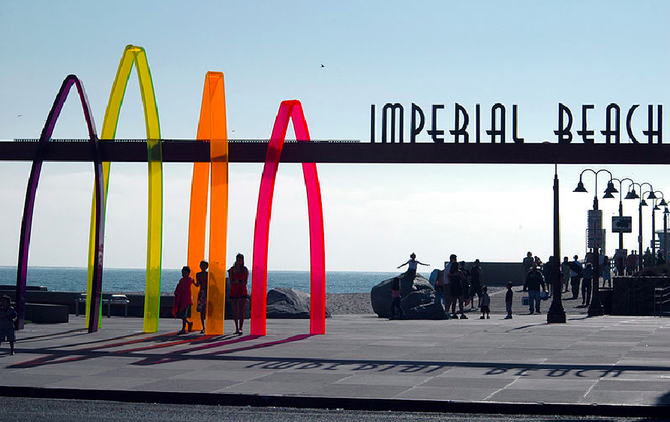 Facebook
Facebook
 X
X
 Instagram
Instagram
 TikTok
TikTok
 Youtube
Youtube

Strollers at the Imperial Beach Pier were recently greeted by a sign at the entrance proclaiming that improvements — mainly refurbishing and replacing worn, warped, wooden planks — are being carried out “at no cost to the taxpayers.” The exact verbiage reads: "Another Port District Improvement Accomplished At No Cost To The Taxpayers."
According to port spokeswoman Tanya Castaneda, the bill for what's officially dubbed the Imperial Beach Pier Deck Refurbishment comes to $420,000 and gets paid for strictly from fees that the Unified Port of San Diego collects for rental space and various services, and not from tax revenue; it comes out of a fund called “major maintenance.”
The state legislation that established the San Diego Unified Port District in 1962 enabled the commission to levy taxes on businesses and homeowners in the cities within its jurisdiction (Imperial Beach, Coronado, Chula Vista, National City, and San Diego) but none have been imposed for decades. As a public trust and self-described “steward of the public tidelands,” the port raises revenue through fees and leases. According to Castaneda. not since 1964 have taxpayers been asked to pony up for capital improvements at the port. The voters that year approved a $10.9 million bond to develop a new air terminal, prepare Harbor Island for leasing, and build a new cargo facility in National City.
How long before construction is complete remains an open question. An estimated completion date of mid-May has come and gone. According to the spokeswoman, progress depends on when the port and its contractor, Kearny Mesa–based Khavari Construction Inc., acquires the lumber required — Douglas fir, cut typically into planks 24 feet long, 12 inches wide, and 4 inches thick. Each plank is said to weigh about 250 pounds.
About 70 percent of the planks on the pier (or about 840 of them) will have been replaced once the project is done. The last plank replacement and refurbishing project at the pier was in 2010.


Strollers at the Imperial Beach Pier were recently greeted by a sign at the entrance proclaiming that improvements — mainly refurbishing and replacing worn, warped, wooden planks — are being carried out “at no cost to the taxpayers.” The exact verbiage reads: "Another Port District Improvement Accomplished At No Cost To The Taxpayers."
According to port spokeswoman Tanya Castaneda, the bill for what's officially dubbed the Imperial Beach Pier Deck Refurbishment comes to $420,000 and gets paid for strictly from fees that the Unified Port of San Diego collects for rental space and various services, and not from tax revenue; it comes out of a fund called “major maintenance.”
The state legislation that established the San Diego Unified Port District in 1962 enabled the commission to levy taxes on businesses and homeowners in the cities within its jurisdiction (Imperial Beach, Coronado, Chula Vista, National City, and San Diego) but none have been imposed for decades. As a public trust and self-described “steward of the public tidelands,” the port raises revenue through fees and leases. According to Castaneda. not since 1964 have taxpayers been asked to pony up for capital improvements at the port. The voters that year approved a $10.9 million bond to develop a new air terminal, prepare Harbor Island for leasing, and build a new cargo facility in National City.
How long before construction is complete remains an open question. An estimated completion date of mid-May has come and gone. According to the spokeswoman, progress depends on when the port and its contractor, Kearny Mesa–based Khavari Construction Inc., acquires the lumber required — Douglas fir, cut typically into planks 24 feet long, 12 inches wide, and 4 inches thick. Each plank is said to weigh about 250 pounds.
About 70 percent of the planks on the pier (or about 840 of them) will have been replaced once the project is done. The last plank replacement and refurbishing project at the pier was in 2010.